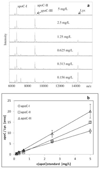Development of multiplex mass spectrometric immunoassay for detection and quantification of apolipoproteins C-I, C-II, C-III and their proteoforms
- PMID: 25752847
- PMCID: PMC4574700
- DOI: 10.1016/j.ymeth.2015.02.020
Development of multiplex mass spectrometric immunoassay for detection and quantification of apolipoproteins C-I, C-II, C-III and their proteoforms
Abstract
The impetus for discovery and evaluation of protein biomarkers has been accelerated by recent development of advanced technologies for rapid and broad proteome analyses. Mass spectrometry (MS)-based protein assays hold great potential for in vitro biomarker studies. Described here is the development of a multiplex mass spectrometric immunoassay (MSIA) for quantification of apolipoprotein C-I (apoC-I), apolipoprotein C-II (apoC-II), apolipoprotein C-III (apoC-III) and their proteoforms. The multiplex MSIA assay was fast (∼ 40 min) and high-throughput (96 samples at a time). The assay was applied to a small cohort of human plasma samples, revealing the existence of multiple proteoforms for each apolipoprotein C. The quantitative aspect of the assay enabled determination of the concentration for each proteoform individually. Low-abundance proteoforms, such as fucosylated apoC-III, were detected in less than 20% of the samples. The distribution of apoC-III proteoforms varied among samples with similar total apoC-III concentrations. The multiplex analysis of the three apolipoproteins C and their proteoforms using quantitative MSIA represents a significant step forward toward better understanding of their physiological roles in health and disease.
Keywords: Apolipoprotein C-I, C-II, C-III; Biomarkers; Mass spectrometric immunoassay; Proteoforms; Quantification.
Copyright © 2015 Elsevier Inc. All rights reserved.
Figures



Similar articles
-
Mass spectrometric immunoassays for discovery, screening and quantification of clinically relevant proteoforms.Bioanalysis. 2016 Aug;8(15):1623-1633. doi: 10.4155/bio-2016-0060. Epub 2016 Jul 11. Bioanalysis. 2016. PMID: 27396364 Free PMC article. Review.
-
Simultaneous Quantification of Apolipoprotein C-III O-Glycoforms by Protein-MRM.J Proteome Res. 2023 Jan 6;22(1):91-100. doi: 10.1021/acs.jproteome.2c00490. Epub 2022 Nov 21. J Proteome Res. 2023. PMID: 36412001
-
ApoC-III proteoforms are associated with better lipid, inflammatory, and glucose profiles independent of total apoC-III.Cardiovasc Diabetol. 2024 Dec 4;23(1):433. doi: 10.1186/s12933-024-02531-5. Cardiovasc Diabetol. 2024. PMID: 39633383 Free PMC article.
-
Disialylated apolipoprotein C-III proteoform is associated with improved lipids in prediabetes and type 2 diabetes.J Lipid Res. 2016 May;57(5):894-905. doi: 10.1194/jlr.P064816. Epub 2016 Mar 3. J Lipid Res. 2016. PMID: 26945091 Free PMC article.
-
Mass Spectrometric Studies of Apolipoprotein Proteoforms and Their Role in Lipid Metabolism and Type 2 Diabetes.Proteomes. 2017 Oct 15;5(4):27. doi: 10.3390/proteomes5040027. Proteomes. 2017. PMID: 29036931 Free PMC article. Review.
Cited by
-
Mass Spectrometric Immunoassays in Characterization of Clinically Significant Proteoforms.Proteomes. 2016 Mar 17;4(1):13. doi: 10.3390/proteomes4010013. Proteomes. 2016. PMID: 28248223 Free PMC article. Review.
-
Mass spectrometric immunoassays for discovery, screening and quantification of clinically relevant proteoforms.Bioanalysis. 2016 Aug;8(15):1623-1633. doi: 10.4155/bio-2016-0060. Epub 2016 Jul 11. Bioanalysis. 2016. PMID: 27396364 Free PMC article. Review.
-
The Roles of ApoC-III on the Metabolism of Triglyceride-Rich Lipoproteins in Humans.Front Endocrinol (Lausanne). 2020 Jul 28;11:474. doi: 10.3389/fendo.2020.00474. eCollection 2020. Front Endocrinol (Lausanne). 2020. PMID: 32849270 Free PMC article. Review.
-
Two decades of immunocapture liquid chromatography tandem mass spectrometry for pharmaceutical discovery and development: reflections and recommendations for optimal deployment.Bioanalysis. 2025 Jan;17(2):79-82. doi: 10.1080/17576180.2024.2415763. Epub 2024 Oct 28. Bioanalysis. 2025. PMID: 39466131 No abstract available.
-
Mass Spectrometry Approaches to Glycomic and Glycoproteomic Analyses.Chem Rev. 2018 Sep 12;118(17):7886-7930. doi: 10.1021/acs.chemrev.7b00732. Epub 2018 Mar 19. Chem Rev. 2018. PMID: 29553244 Free PMC article. Review.
References
Publication types
MeSH terms
Substances
Grants and funding
LinkOut - more resources
Full Text Sources
Other Literature Sources

